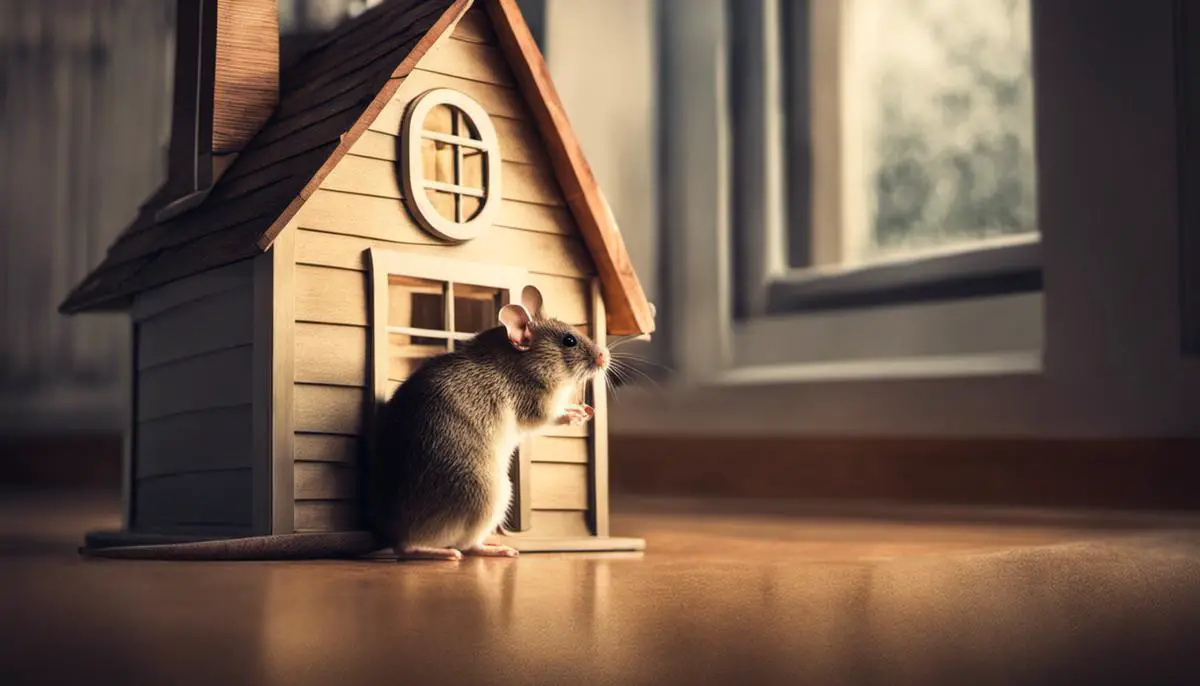Do it Yourself or DIY is not just about building bookshelves or creating homemade crafts; it can also extend to pest control, specifically dealing with mice. One of the most pervasive household pests, mice can create considerable havoc and health issues in human environments. This multi-faceted guide will empower you with intellect and insight on identification, prevention, DIY traps, and home repairs about mice infestation.
Getting acquainted with mouse behavior, their feeding habits, and common nests will step up your identification and prevention game. The knowledge equips you with the ability to nip the problem in the bud–to prevent an infestation before it can materialize. Plus, in the DIY Mouse Traps section, there is an array of cost-effective, simple-to-set-up traps that can turn the tables on these pests. It’s not just about creating traps; it’s about outsmarting them. And, of course, proper home repairs and thorough cleanliness give you an upper hand in this fight against these uninvited guests.
Identification and Prevention
Title: Quick Guide: Identify and Prevent a Mouse Infestation for Your Home’s Peace of Mind
When it comes to building a safe and cozy nest for your beloved family, nothing can be as distressing as discovering uninvited guests, such as mice! Thankfully, there are a few practical actions that every parent can take to both identify and prevent these tiny intruders from making a home within your home.
Identifying a Mouse Infestation:
- Mouse sightings – If you’re seeing a mouse around the house, especially during the day, this is typically an indicator that you have a mouse infestation. Generally, mice are nocturnal creatures and prefer to stay hidden.
- Noises – Mice are rather elusive, so you might not see them, but you can often hear them. Listen for noises in walls or ceilings, particularly at night. Scratching, scrambling, or squeaking sounds are a telltale sign.
- Droppings – Mice droppings are often the first (and most telltale) sign of an infestation. These dark, rice-sized droppings can often be found along baseboards, inside pantries, or in the backs of drawers.
- Nests – Mice create nests using shredded paper or other fibrous material. These nests are often found in sheltered locations like behind fridges, freezers, closets, or in basements.
Preventing a Mouse Infestation:
- Seal Entry Points – Mice can squeeze through surprisingly small holes. Walk along the exterior of your house and try to locate any gaps or holes, paying special attention to where pipes enter the house. Use steel wool or caulking to seal these potential entry points.
- Cleanliness is Key – Mice will be attracted to food left lying around, so keeping your home clean is a crucial step in maintaining a mouse-free space. Ensure all food is stored in airtight containers and clean up crumbs and spills promptly.
- Remove Potential Nesting Sites – Regularly check basements, attics, and storage areas for signs of mice activity. By keeping these areas tidy and uncluttered, you reduce the potential for a mouse infestation.
- Professional Pest Control – If you have successfully identified a mouse infestation, consider calling in professional help. Pest control teams can assess the extent of the issue and implement a comprehensive eradication plan, ensuring peace of mind for you and your home.
Mice infestations can be stressful, but don’t let it get you down parents! Remember, with careful education and preventive strategies, you can keep your home cozy and critter-free, building a safer space for your family to thrive.

DIY Mouse Traps
Let’s Talk About DIY Mouse Traps: A Homeowner’s Guide
First things first, it’s essential to compliment every homeowner out there who’s taken the necessary steps to identify and prevent a mouse infestation. You’ve done a fantastic job keeping your lovely abode cozy, clean, and completely critter-free. But sometimes, despite our best efforts, these tiny uninvited guests might still find a way in. When that happens, one of the most cost-effective steps homeowners can take is setting up DIY mouse traps. So, what are the most effective DIY mouse traps you can make? Let’s dive right into it.
- The Bucket Trap: This popular DIY mousetrap requires a bucket, a wire hanger, a soda can, some peanut butter, and a piece of wood. Form the hanger into a ramp leading up to the bucket rim, put the soda can on the wire hanging over the bucket, and smear peanut butter on the can. The mouse will walk up the ramp, try to reach the bait, causing the can to spin and the mouse to fall into the bucket. Just remember, you still have to decide how to humanely remove the mouse.
- The Glass Bowl and Coin Trap: You need a large bowl or glass (heavy enough that a mouse can’t move it), a piece of cardboard, bait like cheese or chocolate, and a coin. Place bait on one end of the cardboard and prop up the other end using the coin. When the mouse goes for the bait, the setup becomes imbalanced, leading the bowl to trap the mouse.
- The Toilet Paper Roll Trap: This one requires just an empty toilet paper roll, a tall trash can, and some bait. Flatten one side of the roll so it can balance on the edge of a table or counter and put bait on the far end. When the mouse enters the roll, trying to get the bait, the roll will tip, dropping the mouse into the trash can.
- The Sticky Trap: This quite effective method involves using heavy-duty double-sided tape or homemade non-toxic sticky glue. Just place the tape or glue on a solid surface and place food bait in the middle. Once they step onto the sticky surface, they’ll be trapped. It’s worth mentioning that some people find this method inhumane due to the distress it may cause the mouse.
As you repurpose everyday items into clever mousetraps, remember that the key to success lies in placement. Usually, the best spots are along walls or in darker corners, where mice typically travel.
In a nutshell, taking the DIY route for mouse control can be a fun and intelligent way of dealing with an unpleasant problem. Plus, it comes with the added satisfaction of solving an issue right from your home toolbox. However, always remember to treat the captured mice ethically and kindly when disposing or relocating them.
Let’s keep our homes warm, beautiful, and free of unwanted visitors without losing our sense of compassion. Happy DIYing, everyone!

Home Repairs and Maintenance
Creating a mouse-free home is such a crucial part of maintaining a happy, healthy living environment for our families. Isn’t it wonderful when we can utilize our DIY skills to ensure our home is secure, and our loved ones are safe? There’s a certain satisfaction when you know you’ve taken tangible steps to protect your home from these small intruders.
DIY mouse traps are a cost-effective measure every homeowner should consider in their arsenal against mice. Not only can it save you a few bucks, but it also appeals to our creative sides and bereaves us a sense of control over a situation that has the potential to spiral.
Now, let’s explore some DIY mousetrap options.
The Bucket Trap
The Bucket Trap is a popular method because it’s uncomplicated to set up. You’ll need a bucket, a wire hanger, a soda can, some peanut butter, and a piece of wood. Hang the soda can in the center of the wire across the bucket and coat it with peanut butter. Then lean the piece of wood against the bucket, creating a ramp for the mouse. Once a mouse climbs up and tries to reach for the bait, it will fall into the bucket and remain trapped.
The Glass Bowl and Coin Trap
The Glass Bowl and Coin Trap is creative yet straightforward. For this, you need a coin, a glass bowl, and tempting bait such as cheese or chocolate. Place your bait underneath the bowl and prop up one side of the bowl with the coin. When the mouse nudges the coin to reach the bait, the bowl will trap it inside.
The Toilet Paper Roll Trap
The Toilet Paper Roll Trap involves a used toilet paper roll, a piece of paper or cardboard as a ramp, bait like peanut butter, and a tall bin. Simply bait one end of the roll and place the baited end hanging precariously over a countertop with a bin underneath. The mouse should move into the roll, upsetting the balance and dropping it and the mouse into the bin.
The Sticky Trap
The Sticky Trap requires a board or heavyweight paper, some glue, and bait. Spread the glue all over the board and place the bait in the middle. The downside of this trap is that it’s considered less humane as the mouse can suffer before being released or passing away.
Proper placement of these traps around your home is key to successfully capturing mice. High traffic areas such as corners, walls, or areas where you’ve spotted mice or their droppings are ideal locations.
A cheerful salute to everyone who takes up this DIY mouse control! What could be more gratifying than knowing we’ve made our homes safer and more comfortable in a hands-on, cost-effective way?
In catching mice, it’s always important to remember to treat every creature with kindness. If you catch a live mouse, considering releasing it away from your home.
In conclusion, take courage! Facing a mouse problem head-on with these household materials is not only empowering but also contributes to a better-kept, mouse-free home for you and your family. Let’s all take the initiative and protect our homes! Isn’t it satisfying to be able to handle issues that pop up in our homes with our own two hands? After all, home maintenance is one of the many unspoken joys of parenting!

The power lies in your hands to create a mouse-free home environment. With the practical, DIY mouse control tips detailed in this guide, you can gain control over your indoor environment. No more wondering about how mice operate or where they hide; instead, you will now be armed with the knowledge to anticipate and handle any scenario. Moreover, with user-friendly DIY traps and home maintenance tips, you can take swift action that sends the mice scurrying.
Every household faces unwanted pests like mice. But with strategic prevention methods, clever DIY traps, and consistent home maintenance, our homes can become less inviting to them. So get started today – read the advice, build your strategy, set your traps, and maintain your home. You’re well on your way to a mouse-free environment. Remember, when it comes to dealing with mice, knowledge is your best weapon. So, arm yourself with it and take action!








